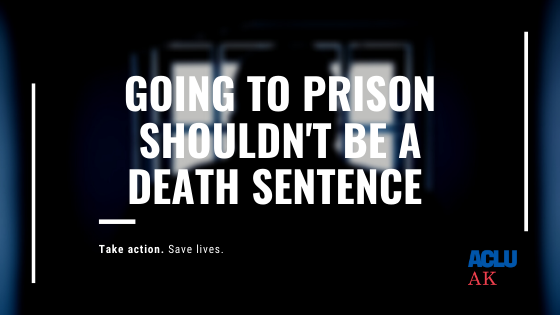The ACLU of Alaska is urging the Alaska Vaccine Allocation Advisory Committee (AVAAC) to prioritize all incarcerated people in the Phase 1b of distribution and on equal terms with other congregate settings. Department of Corrections (DOC) staff who come into close contact with incarcerated people should be concurrently prioritized.
“We recognize that vaccine allocation and distribution present a tremendous challenge to state officials, who must balance a number of different public-health and practical considerations. But a vaccine-distribution plan cannot be considered fair or equitable if it fails to take in account, and attempt to redress, the disproportionate impact the pandemic has had on those detained by, and in the care of DOC,” ACLU of Alaska Advocacy Director Michael Garvey said.
COVID-19 has wreaked havoc on the lives of more than 4,000 people warehoused in Alaska’s jails and prisons. The largest outbreak in the state began to erupt at the Goose Creek Correctional Center last month, three people have died within the last month, and prisoners have been without rehabilitation opportunities for most of the year. The incarcerated population has an infection rate 500 percent higher than the state’s overall infection rate, a crisis exacerbated by several factors.
Alaska’s in the midst of a mass incarceration crisis. Incarcerated people continue to report being housed in gymnasiums with 10-plus other people and sleeping on “boats” on jail cell floors.
Incarcerated people have little to no control to their exposure to COVID-19. They often lack adequate nutrition, health care, access to fresh air, and limited access to basic hygiene products.
Incarcerated people have higher rates of chronic health issues due, in part, to the physical stress and strain of imprisonment. They have higher rates of disabilities, which includes chronic health issues. For instance, four of five incarcerated individuals suffer from substance use disorders and approximately 44 percent have a diagnosed mental health issue.
The prison population is also aging. Between 2015 and 2019, the number of incarcerated individuals aged 60 and above increased 26.5 percent.
Alaska Native and Black people — who experience higher rates of infection, hospitalization, and death from COVID-19 — are disproportionately represented in the state’s prisons. Alaska Native people account for 16 percent of the state’s population, yet they account for 40 percent of the prison population. Black people account for 10 percent of the incarcerated population, yet they make up four percent of the general population.
The ACLU of Alaska is also calling on the AVAAC to improve public transparency throughout their processes and has requested the Committee livestream meetings.
“Decisions regarding which populations are prioritized must be made in a transparent, evidence-based, and impartial manner that includes input from these especially vulnerable, and often powerless, communities. While the Committee has provided public comment opportunities, there is immense value in the public understanding how the Committee evaluates input and makes decisions,” Garvey said.
Read the letter to AVAAC, here.

